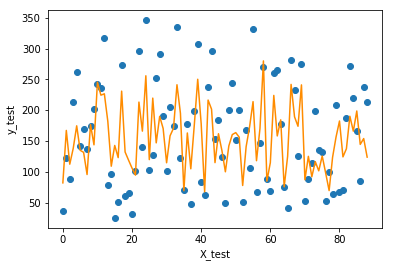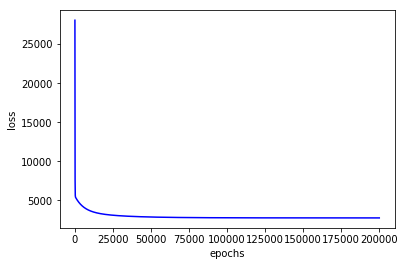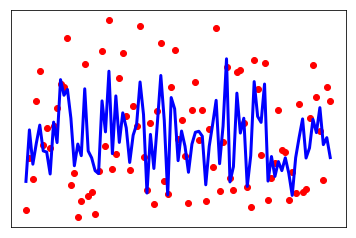线性回归
2022-01-12 10:08
851 查看
1 导入依赖包
import numpy as np import pandas as pd
2 初始化模型参数
### 初始化模型参数 def initialize_params(dims): ''' 输入: dims:训练数据变量维度 输出: w:初始化权重参数值 b:初始化偏差参数值 ''' # 初始化权重参数为零矩阵 w = np.zeros((dims, 1)) # 初始化偏差参数为零 b = 0 return w, b
3 定义模型主体部分
### 定义模型主体部分 ### 包括线性回归公式、均方损失和参数偏导三部分 def linear_loss(X, y, w, b): ''' 输入: X:输入变量矩阵 y:输出标签向量 w:变量参数权重矩阵 b:偏差项 输出: y_hat:线性模型预测输出 loss:均方损失值 dw:权重参数一阶偏导 db:偏差项一阶偏导 ''' # 训练样本数量 num_train = X.shape[0] # 训练特征数量 num_feature = X.shape[1] # 线性回归预测输出 y_hat = np.dot(X, w) + b # 计算预测输出与实际标签之间的均方损失 loss = np.sum((y_hat-y)**2)/num_train # 基于均方损失对权重参数的一阶偏导数 dw = np.dot(X.T, (y_hat-y)) /num_train # 基于均方损失对偏差项的一阶偏导数 db = np.sum((y_hat-y)) /num_train return y_hat, loss, dw, db
4 定义线性回归模型训练过程
### 定义线性回归模型训练过程
def linear_train(X, y, learning_rate=0.01, epochs=10000):
'''
输入:
X:输入变量矩阵
y:输出标签向量
learning_rate:学习率
epochs:训练迭代次数
输出:
loss_his:每次迭代的均方损失
params:优化后的参数字典
grads:优化后的参数梯度字典
'''
# 记录训练损失的空列表
loss_his = []
# 初始化模型参数
w, b = initialize_params(X.shape[1])
# 迭代训练
for i in range(1, epochs):
# 计算当前迭代的预测值、损失和梯度
y_hat, loss, dw, db = linear_loss(X, y, w, b)
# 基于梯度下降的参数更新
w += -learning_rate * dw
b += -learning_rate * db
# 记录当前迭代的损失
loss_his.append(loss)
# 每1000次迭代打印当前损失信息
if i % 10000 == 0:
print('epoch %d loss %f' % (i, loss))
# 将当前迭代步优化后的参数保存到字典
params = {
'w': w,
'b': b
}
# 将当前迭代步的梯度保存到字典
grads = {
'dw': dw,
'db': db
}
return loss_his, params, grads
5 加载数据集
from sklearn.datasets import load_diabetes diabetes = load_diabetes() data = diabetes.data target = diabetes.target print(data.shape) print(target.shape) print(data[:5]) print(target[:5])
(442, 10) (442,) [[ 0.03807591 0.05068012 0.06169621 0.02187235 -0.0442235 -0.03482076 -0.04340085 -0.00259226 0.01990842 -0.01764613] [-0.00188202 -0.04464164 -0.05147406 -0.02632783 -0.00844872 -0.01916334 0.07441156 -0.03949338 -0.06832974 -0.09220405] [ 0.08529891 0.05068012 0.04445121 -0.00567061 -0.04559945 -0.03419447 -0.03235593 -0.00259226 0.00286377 -0.02593034] [-0.08906294 -0.04464164 -0.01159501 -0.03665645 0.01219057 0.02499059 -0.03603757 0.03430886 0.02269202 -0.00936191] [ 0.00538306 -0.04464164 -0.03638469 0.02187235 0.00393485 0.01559614 0.00814208 -0.00259226 -0.03199144 -0.04664087]] [151. 75. 141. 206. 135.]
6 划分数据集
# 导入sklearn diabetes数据接口
from sklearn.datasets import load_diabetes
# 导入sklearn打乱数据函数
from sklearn.utils import shuffle
# 获取diabetes数据集
diabetes = load_diabetes()
# 获取输入和标签
data, target = diabetes.data, diabetes.target
# 打乱数据集
X, y = shuffle(data, target, random_state=13)
# 按照8/2划分训练集和测试集
offset = int(X.shape[0] * 0.8)
# 训练集
X_train, y_train = X[:offset], y[:offset]
# 测试集
X_test, y_test = X[offset:], y[offset:]
# 将训练集改为列向量的形式
y_train = y_train.reshape((-1,1))
# 将验证集改为列向量的形式
y_test = y_test.reshape((-1,1))
# 打印训练集和测试集维度
print("X_train's shape: ", X_train.shape)
print("X_test's shape: ", X_test.shape)
print("y_train's shape: ", y_train.shape)
print("y_test's shape: ", y_test.shape)
7 训练
# 线性回归模型训练 loss_his, params, grads = linear_train(X_train, y_train, 0.01, 200000) # 打印训练后得到模型参数 print(params)
epoch 10000 loss 3679.868273
epoch 20000 loss 3219.164522
epoch 30000 loss 3040.820279
epoch 40000 loss 2944.936608
epoch 50000 loss 2885.991571
epoch 60000 loss 2848.051813
epoch 70000 loss 2823.157085
epoch 80000 loss 2806.627821
epoch 90000 loss 2795.546917
epoch 100000 loss 2788.051561
epoch 110000 loss 2782.935842
epoch 120000 loss 2779.411265
epoch 130000 loss 2776.957989
epoch 140000 loss 2775.230803
epoch 150000 loss 2773.998942
epoch 160000 loss 2773.107192
epoch 170000 loss 2772.450534
epoch 180000 loss 2771.957489
epoch 190000 loss 2771.579121
{'w': array([[ 10.56390075],
[-236.41625133],
[ 481.50915635],
[ 294.47043558],
[ -60.99362023],
[-110.54181897],
[-206.44046579],
[ 163.23511378],
[ 409.28971463],
[ 65.73254667]]), 'b': 150.8144748910088}
7 定义线性回归预测函数
### 定义线性回归预测函数 def predict(X, params): ''' 输入: X:测试数据集 params:模型训练参数 输出: y_pred:模型预测结果 ''' # 获取模型参数 w = params['w'] b = params['b'] # 预测 y_pred = np.dot(X, w) + b return y_pred # 基于测试集的预测 y_pred = predict(X_test, params) # 打印前五个预测值 y_pred[:5]
array([[ 82.0537503 ], [167.22420149], [112.38335719], [138.15504748], [174.71840809]])
print(y_test[:5])
[[ 37.] [122.] [ 88.] [214.] [262.]]
8 定义R2系数函数
### 定义R2系数函数 def r2_score(y_test, y_pred): ''' 输入: y_test:测试集标签值 y_pred:测试集预测值 输出: r2:R2系数 ''' # 测试标签均值 y_avg = np.mean(y_test) # 总离差平方和 ss_tot = np.sum((y_test - y_avg)**2) # 残差平方和 ss_res = np.sum((y_test - y_pred)**2) # R2计算 r2 = 1 - (ss_res/ss_tot) return r2
print(r2_score(y_test, y_pred))
0.5334188457463576
9 可视化手动实现的线性回归结果
import matplotlib.pyplot as plt
f = X_test.dot(params['w']) + params['b']
plt.scatter(range(X_test.shape[0]), y_test)
plt.plot(f, color = 'darkorange')
plt.xlabel('X_test')
plt.ylabel('y_test')
plt.show();

plt.plot(loss_his, color = 'blue')
plt.xlabel('epochs')
plt.ylabel('loss')
plt.show()

10 交叉验证
from sklearn.utils import shuffle X, y = shuffle(data, target, random_state=13) X = X.astype(np.float32) data = np.concatenate((X, y.reshape((-1,1))), axis=1) data.shape
(442, 11)
from random import shuffle
def k_fold_cross_validation(items, k, randomize=True):
if randomize:
items = list(items)
shuffle(items)
slices = [items[i::k] for i in range(k)]
for i in range(k):
validation = slices[i]
training = [item
for s in slices if s is not validation
for item in s]
training = np.array(training)
validation = np.array(validation)
yield training, validation
for training, validation in k_fold_cross_validation(data, 5):
X_train = training[:, :10]
y_train = training[:, -1].reshape((-1,1))
X_valid = validation[:, :10]
y_valid = validation[:, -1].reshape((-1,1))
loss5 = []
#print(X_train.shape, y_train.shape, X_valid.shape, y_valid.shape)
loss, params, grads = linar_train(X_train, y_train, 0.001, 100000)
loss5.append(loss)
score = np.mean(loss5)
print('five kold cross validation score is', score)
y_pred = predict(X_valid, params)
valid_score = np.sum(((y_pred-y_valid)**2))/len(X_valid)
print('valid score is', valid_score)
(353, 10) (353, 1) (89, 10) (89, 1) epoch 10000 loss 5667.323261 epoch 20000 loss 5365.061628 epoch 30000 loss 5104.951009 epoch 40000 loss 4880.559191 epoch 50000 loss 4686.465012 epoch 60000 loss 4518.097942 epoch 70000 loss 4371.603217 epoch 80000 loss 4243.728424 epoch 90000 loss 4131.728130 five kold cross validation score is 4033.2928969313452 valid score is 3558.147428823725 (353, 10) (353, 1) (89, 10) (89, 1) epoch 10000 loss 5517.461607 epoch 20000 loss 5181.523292 epoch 30000 loss 4897.000442 epoch 40000 loss 4655.280406 epoch 50000 loss 4449.235361 epoch 60000 loss 4272.963989 epoch 70000 loss 4121.578253 epoch 80000 loss 3991.027359 epoch 90000 loss 3877.952427 five kold cross validation score is 3779.575673476155 valid score is 4389.749894361285 (354, 10) (354, 1) (88, 10) (88, 1) epoch 10000 loss 5677.526932 epoch 20000 loss 5331.464606 epoch 30000 loss 5038.541403 epoch 40000 loss 4789.859079 epoch 50000 loss 4578.047735 epoch 60000 loss 4397.001364 epoch 70000 loss 4241.659289 epoch 80000 loss 4107.825490 epoch 90000 loss 3992.019241 five kold cross validation score is 3891.3610347157187 valid score is 3844.049401675179 (354, 10) (354, 1) (88, 10) (88, 1) epoch 10000 loss 5366.435738 epoch 20000 loss 5117.050627 epoch 30000 loss 4902.593420 epoch 40000 loss 4717.676380 epoch 50000 loss 4557.767422 epoch 60000 loss 4419.053021 epoch 70000 loss 4298.323163 epoch 80000 loss 4192.874781 epoch 90000 loss 4100.430691 five kold cross validation score is 4019.0791769506664 valid score is 4300.006957377207 (354, 10) (354, 1) (88, 10) (88, 1) epoch 10000 loss 5592.024970 epoch 20000 loss 5278.867272 epoch 30000 loss 5010.647792 epoch 40000 loss 4780.303445 epoch 50000 loss 4581.916469 epoch 60000 loss 4410.526730 epoch 70000 loss 4261.974936 epoch 80000 loss 4132.771612 epoch 90000 loss 4019.987616 five kold cross validation score is 3921.1718979156462 valid score is 3909.701727644273
from sklearn.datasets import load_diabetes from sklearn.utils import shuffle from sklearn.model_selection import train_test_split diabetes = load_diabetes() data = diabetes.data target = diabetes.target X, y = shuffle(data, target, random_state=13) X = X.astype(np.float32) y = y.reshape((-1, 1)) X_train, X_test, y_train, y_test = train_test_split(X, y, test_size=0.2, random_state=42) print(X_train.shape, y_train.shape, X_test.shape, y_test.shape)
(353, 10) (353, 1) (89, 10) (89, 1)
11 sklearn实现线性回归
import matplotlib.pyplot as plt
import numpy as np
from sklearn import linear_model
from sklearn.metrics import mean_squared_error, r2_score
regr = linear_model.LinearRegression()
regr.fit(X_train, y_train)
y_pred = regr.predict(X_test)
# The coefficients
print('Coefficients: \n', regr.coef_)
# The mean squared error
print("Mean squared error: %.2f"
% mean_squared_error(y_test, y_pred))
# Explained variance score: 1 is perfect prediction
print('Variance score: %.2f' % r2_score(y_test, y_pred))
print(r2_score(y_test, y_pred))
# Plot outputs
plt.scatter(range(X_test.shape[0]), y_test, color='red')
plt.plot(range(X_test.shape[0]), y_pred, color='blue', linewidth=3)
plt.xticks(())
plt.yticks(())
plt.show();
Coefficients: [[ 7.00153867 -244.27466725 488.58606379 301.83242902 -693.67792807 364.02013146 106.15852423 289.24926974 645.158344 50.77526251]] Mean squared error: 3371.88 Variance score: 0.54 0.5392080506325068

import numpy as np
import pandas as pd
from sklearn.utils import shuffle
from sklearn.model_selection import KFold
from sklearn.linear_model import LinearRegression
### 交叉验证
def cross_validate(model, x, y, folds=5, repeats=5):
ypred = np.zeros((len(y),repeats))
score = np.zeros(repeats)
for r in range(repeats):
i=0
print('Cross Validating - Run', str(r + 1), 'out of', str(repeats))
x,y = shuffle(x, y, random_state=r) #shuffle data before each repeat
kf = KFold(n_splits=folds,random_state=i+1000) #random split, different each time
for train_ind, test_ind in kf.split(x):
print('Fold', i+1, 'out of', folds)
xtrain,ytrain = x[train_ind,:],y[train_ind]
xtest,ytest = x[test_ind,:],y[test_ind]
model.fit(xtrain, ytrain)
#print(xtrain.shape, ytrain.shape, xtest.shape, ytest.shape)
ypred[test_ind]=model.predict(xtest)
i+=1
score[r] = R2(ypred[:,r],y)
print('\nOverall R2:',str(score))
print('Mean:',str(np.mean(score)))
print('Deviation:',str(np.std(score)))
pass
cross_validate(regr, X, y, folds=5, repeats=5)
Cross Validating - Run 1 out of 5 Fold 1 out of 5 Fold 2 out of 5 Fold 3 out of 5 Fold 4 out of 5 Fold 5 out of 5 Cross Validating - Run 2 out of 5 Fold 1 out of 5 Fold 2 out of 5 Fold 3 out of 5 Fold 4 out of 5 Fold 5 out of 5 Cross Validating - Run 3 out of 5 Fold 1 out of 5 Fold 2 out of 5 Fold 3 out of 5 Fold 4 out of 5 Fold 5 out of 5 Cross Validating - Run 4 out of 5 Fold 1 out of 5 Fold 2 out of 5 Fold 3 out of 5 Fold 4 out of 5 Fold 5 out of 5 Cross Validating - Run 5 out of 5 Fold 1 out of 5 Fold 2 out of 5 Fold 3 out of 5 Fold 4 out of 5 Fold 5 out of 5 Overall R2: [-670.4095204 -671.45443974 -673.60734422 -671.40192667 -675.31208185] Mean: -672.437062575318 Deviation: 1.77669784591671
相关文章推荐
- 利用最小二乘法实现图片中多个点的一元线性回归
- 线性回归(linear regression)
- MATLAB 线性回归
- 机器学习 --- 1. 线性回归与分类, 解决与区别
- Coursera公开课笔记: 斯坦福大学机器学习第四课“多变量线性回归(Linear Regression with Multiple Variables)”
- 第二讲.Linear Regression with multiple variable (多变量线性回归)
- 机器学习练习之线性回归
- matlab线性回归程序
- 机器学习入门——单变量线性回归
- 机器学习中的数学(2)-线性回归,偏差、方差权衡
- 线性回归
- machine learning(线性回归)
- 理解线性回归(三)——岭回归Ridge Regression
- 参数线性回归和梯度下降
- Machine Learning - II. Linear Regression with One Variable单变量线性回归 (Week 1)
- 线性回归
- Stanford机器学习---第二讲. 多变量线性回归 Linear Regression with multiple variable
- Spark(十一) -- Mllib API编程 线性回归、KMeans、协同过滤演示
- 广义线性回归拟合教程和源码
- Deep learning:五(regularized线性回归练习)
